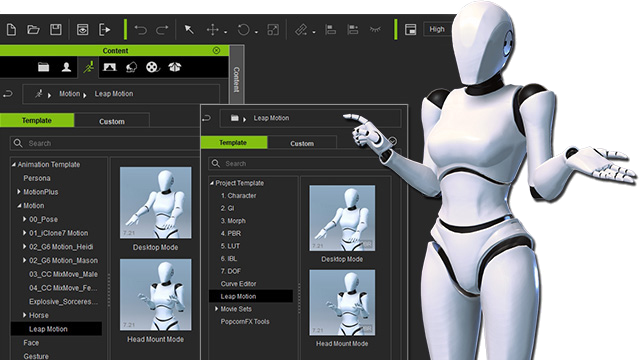This week we’re excited to share a new engine integration with the professional animation community – Leap Motion and iClone 7 Motion LIVE. A full body motion capture platform designed for performance animation, Motion LIVE aggregates motion data streams from industry-leading mocap devices, and drives 3D characters’ faces, hands, and bodies simultaneously. Its easy workflow […]
// Art & Design

Last time, we looked at how an interactive VR sculpture could be created with the Leap Motion Graphic Renderer as part of an experiment in interaction design. With the sculpture’s shapes rendering, we can now craft and code the layout and control of this 3D shape pool and the reactive behaviors of the individual objects.
By adding the Interaction Engine to our scene and InteractionBehavior components to each object, we have the basis for grasping, touching and other interactions. But for our VR sculpture, we can also use the Interaction Engine’s robust and performant awareness of hand proximity. With this foundation, we can experiment quickly with different reactions to hand presence, pinching, and touching specific objects. Let’s dive in!
With the 3D Jam just around the corner, we thought we’d give you a headstart – with a full guide to the very latest resources to bring your to life. In this post, we’ll cover everything you need to know about our integrations and best practices for augmented and virtual reality, desktop, and the Internet of Things. A […]
What makes a collection of pixels into a magic experience? The art of storytelling. At the latest VRLA Summer Expo, creative coder Isaac Cohen (aka Cabbibo) shared his love for the human possibilities of virtual reality, digital experiences, and the power of hugs. Isaac opens the talk by thinking about how we create the representation […]
Music videos have evolved significantly since TRL. Last week, we were thrilled to come across a new release from Darwin Deez called Kill Your Attitude, where the perils of modern love take some truly bizarre emotional and technical twists. Love (literally) becomes a battlefield when Darwin’s angry girlfriend becomes the player in a first-person shooter, taking the central conflict to some vividly imaginative heights as she hunts him down for great justice.

Among developers, interactive designers, and digital artists, Processing is an enormously popular way to build compelling experiences with minimal coding. We’ve seen hundreds of Leap Motion experiments using Processing, from Arduino hacks to outdoor art installations, and the list grows every week.
James Britt, aka Neurogami, is the developer behind the LeapMotionP5 library, which brings together our Java API with the creative power of Processing. He’s just rolled out a major update to the library, including a new boilerplate demo and a demo designed to bridge hand input with musical output. We caught up with James to ask about the library, his latest examples, and how you can get started.
As our physical reality becomes increasingly augmented, creative coders are able to access a whole new trove of intriguing possibilities. Several weeks back, we stumbled upon one such experiment called TACTUM, an unusual combination of projection mapping, motion controls, depth sensing, and 3D printing to create customized wearables. With all that technology, the design process is surprisingly simple – all you need is the light on your skin.
When virtual reality and musical interface design collide, entire universes can be musical instruments. Created by artists Rob Hamilton and Chris Platz for the Stanford Laptop Orchestra, Carillon is a networked VR instrument that brings you inside a massive virtual bell tower. By reaching into the inner workings and playing with the gears, you can create hauntingly beautiful, complex music.
The frustrating thing about raw Twitter data is that it tends to remove the very element that makes the platform so interesting in the first place: the nuance of human sentiment. But what if you could harness the power of that data back with your own two hands, set to music?
Tomorrow in Montreal, audience members at the IX Symposium will see one of Jupiter’s moons appear inside a 60-foot dome. But this isn’t something you can find in a telescope – it’s a trippy virtual environment with stark geometric shapes and classical forms.

